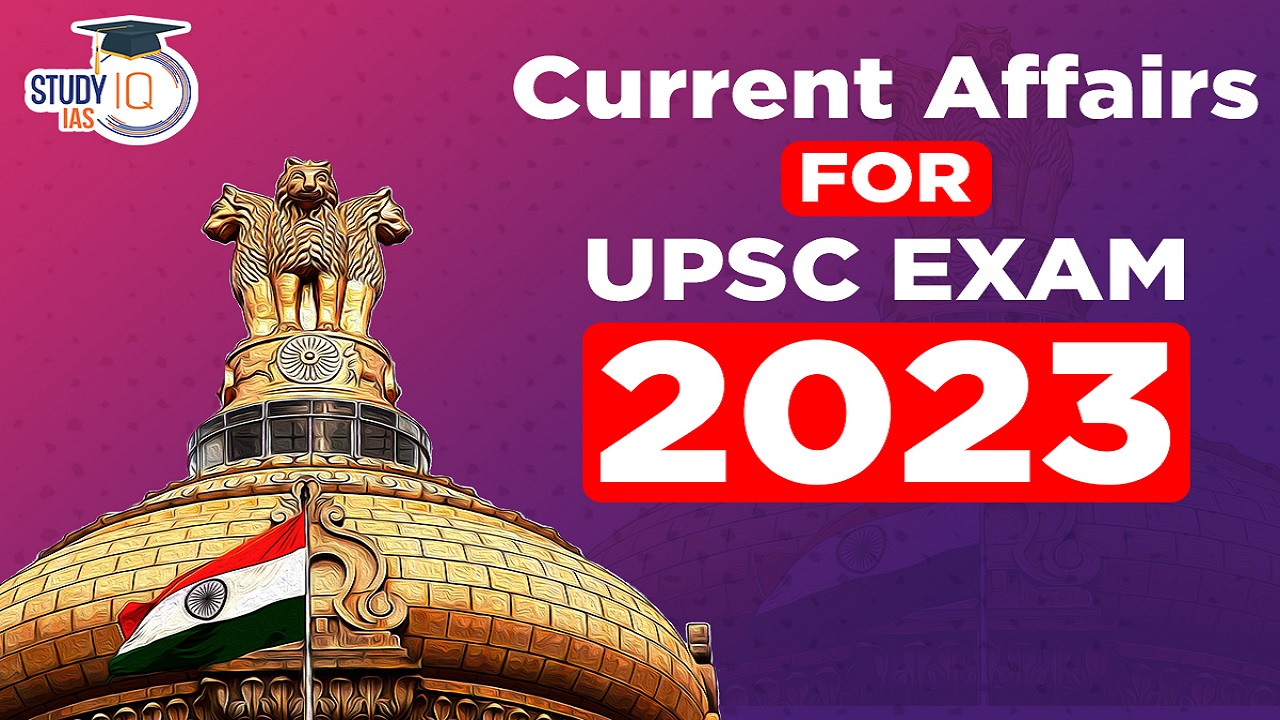Current Affairs 15th July 2023 for UPSC Prelims Exam
IT Amendment Rules, 2023
Context: The Bombay High Court expressed concerns about the distinction between online and print media under the IT (Intermediary Guidelines and Digital Media Ethics Code) Amendment Rules, 2023.
About the IT (Intermediary Guidelines and Digital Media Ethics Code) Amendment Rules, 2023
- In April 2023, the Ministry of Electronics and IT notified amendments to the Information Technology Rules, 2021, which allows the Ministry to appoint the fact-check body.
- Key provisions of the amendment rules:
- Appointment of Fact-check Unit: The Central Government will allow a fact-check body appointed by it to label online content related to the Union Government as “fake” or “misleading”.
- Removal of Fake Content: If any piece of information is marked as fake by the upcoming fact check unit, online intermediaries will be required to take it down. Internet service providers will have to block URLs of such content.
- If online intermediaries fail to remove such content, they would risk losing their safe harbour, which protects them from litigation against third-party content.
- Efforts to Reduce Fake Content: Online intermediaries and internet service providers should make “reasonable efforts” to not host content related to the Central Government that is “identified as fake or misleading” by the fact check unit.
- Framework on Online Gaming: Online intermediaries should make reasonable efforts to not host, publish or share any online game that can cause the user harm, or that has not been permitted by an online gaming self-regulatory body designated by the Central Government.
- The intermediary will also have to ensure that no advertisement or promotion of an online game that is not a permissible online game, is hosted on its platform.
- The amended rules also cast additional obligations on online gaming intermediaries in relation to online games involving real money.
- The Government may create a Board of Directors representing the online gaming industry. It shall have experts, including online games users, educationists, psychology or mental health experts, ICT experts etc.
Criticism of The New Amendment Rules
- Censorship of Press: The Editors Guilds of India has stated that these amendments will have deeply adverse implications for press freedom in the country. The determination of fake news in the sole hands of the government will result in censorship of the press.
- More Power to Fact Checking Unit: New rules may make it easier to muzzle the free press, and will give sweeping powers to the agency authorized by the Central Government for fact checking, to force online intermediaries to take down content that the government may find problematic.
- Curb Legitimate Criticism: New amendments stifle legitimate criticism of the government and will have an adverse impact on the ability of the press to hold governments to account, which is a vital role it plays in a democracy.
- Lack of Governing mechanisms: New rules do not mention any governing mechanism for a fact-checking unit, the judicial oversight, the right to appeal, or adherence to the guidelines laid down by the Supreme Court of India.
Current Affairs 14th July 2023 for UPSC Prelims Exam
Scorpene Class Submarines
Context: The Defence Acquisition Council, the apex decision-making body for the acquisition of military equipment for India’s armed forces, has cleared proposals worth thousands of crores to buy three additional Scorpene submarines.
More on News
- The three additional Scorpene submarines will be procured under Buy (Indian) category and will be built by the Mazagon Dock Shipbuilders Limited (MDL) in Mumbai.
- The MDL is building six Scorpene class submarines under the Project-75, as part of a $ 3.75 billion deal signed in 2005, which allowed for transfer of technology from the French defence firm, Naval Group.
- The fifth submarine under this project, INS Vagir, was commissioned in January 2023.
- The others — INS Kalvari, INS Khanderi, INS Karanj and INS Vela were commissioned between 2017 and 2021.
- In May 2023, the sixth submarine Vagsheer began her sea trials.
About Scorpene Submarines
- Definition: The Scorpene submarines are conventional attack subs, meaning that they are designed to target and sink adversary naval vessels.
- Features: They are capable of launching a large array of torpedoes and missiles.
- They are also equipped with a range of surveillance and intelligence-gathering mechanisms.
- They are around 220 feet long and have a height of approximately 40 feet.
- They can reach the top speeds of 11 knots (20 km/h) when surfaced and 20 knots (37 km/h) when submerged.
- Scorpene class submarines use diesel electric propulsion systems.
- They have an endurance ability to operate independently without refuelling – of approximately 50 days.
- This sort of propulsion system alternates between using diesel (for functioning on the surface) and electric (for functioning underwater).
- However, these electric batteries need to be recharged by the diesel engine after prolonged submersion, meaning that the submarine has to periodically surface to continue operating.
- Difference with Nuclear Submarines: Nuclear submarines are used due to their unlimited endurance.
- A nuclear reactor on a submarine has an operational life of up to 30 years.
- As they are not propelled by batteries, these submarines only need to come to the surface for replenishing supplies for the crew.
- They are also able to move much faster than conventional submarines.
- However, nuclear submarines are expensive and require a significant amount of specialized experience to operate.
- Currently, India has 2 nuclear-powered submarines (SSBMs) of the Arihant class in service.
- With advancements in diesel electric technology, the range of conventional submarines as well as their stealth has gone up significantly.
- Significance of Three Additional Scorpene Submarines for India:
- There was a need to procure the three additional submarines due to the delayed deliveries of submarines under Project 75 as well as to bolster India’s dwindling submarine fleet.
- Currently, the Navy has 16 conventional submarines in service:
- 7 of the Sindhughosh class (Russian Kilo class),
- 4 of the Shishumar class (modified German Type 209) and
- 5 of the Kalvari class (French Scorpene class).
- However, to carry out its full spectrum of operations, the Navy needs at least 18 such submarines.
- At any given time, around 30% of the submarines are under refit, thus further bringing down the strength of operational submarines. The latest Kalvari-class submarines are scheduled to go for upcoming refits very soon.
- The procurement of additional submarines, with higher indigenous content will help in maintaining required force level and operational readiness of the Navy.
- The additional submarines will also create significant employment opportunities in the domestic sector.
- It will also help the MDL in further enhancing its capability and expertise in submarine construction.
- The Indian navy will retrofit all of its Scorpene class submarines with air independent propulsion or AIP systems, beginning in 2024. This will boost their endurance as well as stealth.
- When operating on batteries, AIP-equipped submarines are almost silent, with the only noise coming from the shaft bearings, propeller, and flow around the hull.
Kamaraj Birth Anniversary
Context: 121th Birthday of former Chief Minister of Tamil Nadu, K. Kamaraj is being celebrated on 15 July.
About K. Kamaraj
- July 15 marks the birth anniversary of Kumaraswami Kamaraj, popularly known as Kamaraja for unforgettable role in India’s freedom struggle.
- Birth: Kamaraj was born in southern Tamil Nadu to a family of the Nadar (one of the most depressed castes of Hindu society).

- Contribution in India’s Freedom Struggle:
- Kamaraj joined Indian National Congress at age 17, just as the noncooperation movement (1920–22) led by Mohandas K. Gandhi was getting under way, and became a full-time worker for the independence cause.
- He also participated in the Salt March act of civil disobedience (satyagraha) in 1930 for which he was imprisoned for two years.
- He was released in 1931 as part of the Gandhi-Irwin Pact agreement.
- Kamaraj was elected to the Madras Presidency legislature in 1937 and again in 1946.
- He was also the president of the Indian National Congress for four years from 1964-67.
- He was also a member of the Constituent Assembly that in 1946 drafted the constitution for India.
- He served as the Chief Minister of Madras from 1954 to 1963.
- In 1963, he suggested to Nehru that senior Congress leaders should leave ministerial posts to take up organisational work. This suggestion came to be known as the ‘Kamaraj Plan’, which was designed primarily to dispel from the minds of Congressmen the lure for power, creating in its place a dedicated attachment to the objectives and policies of the organisation.
- He was instrumental in making Lal Bahadur Shastri the Prime Minister after the passing away of Jawaharlal Nehru.
- Contribution to State:
- He is revered as the father of renaissance of Education in Tamil Nadu and Puducherry.
- He was a pioneer of the Mid-Day Meal Scheme in Tamil Nadu, a scheme that revolutionised health and education in the state.
- Kamarajar was posthumously awarded the Bharat Ratna in 1976, India’s highest civilian award.
- He was a visionary leader, known for his simplicity, integrity & deep concern for the poor.
- He will always be remembered for his monumental role in invigorating the State’s education system.
- The Tamil Nadu government has declared July 15 as Education Development Day.
AT1 Bonds
Context: The underwhelming subscription to State Bank of India’s additional tier-1 (AT-1) bond issue has dampened market sentiment and is expected to make fundraising harder for other PSU banks, possibly even leading to delays in certain cases.
What are Additional Tier-1 (AT1) Bonds?
- Basel III: Under the Basel-III norms, banks are asked to maintain a certain minimum level of capital and not lend all the money they receive from deposits.
- According to Basel-III norms, banks’ regulatory capital is divided into Tier 1 and Tier 2.
- Tier 1 Capital: Known as core capital, Tier 1 is used to fund a financial institution’s business activities. After the global financial crisis of 2007-08, it was felt that banks ought to operate with a higher proportion of their own, permanent capital as opposed to borrowed capital. This permanent capital is termed as Tier 1 capital.
- It includes Common Equity Tier 1 (CET1) capital and Additional Tier 1 (AT1) capital.

- AT1 Bonds: To shore up the Tier 1 capital, banks were allowed to raise a special class of bonds known as AT1 bonds from investors.
- Features of AT1 Bonds:
- AT1 bonds, like other bonds, pay regular interest. But they do not have a maturity date, as they are a permanent part of the bank’s capital.
- They are part of a broader family of assets known as contingent convertible bonds, or CoCos.
- They are quasi-equity instruments with features to absorb losses when a bank runs into trouble. In such a situation, the Basel III capital rules allow write down or conversion of these high-return, high-risk bonds into equity to save the bank and keep it afloat as a going concern.
- Call Option: The issuer possesses the call option that permits them to redeem these bonds after a certain period.
- Subordinate to all other Debt: AT1 bonds are subordinate to all other debt and only senior to common equity.
- Strengthen Tier-1 capital: These bonds are typically used by banks to bolster their core or tier-1 capital.
- Regulator: AT-1 bonds are regulated by the Reserve Bank of India (RBI).
- Benefits: They offer higher returns to investors compared with other debt products.
- Risks Involved:
- Like traditional bonds, AT1s make regular interest payments to investors, but they also have triggers that allow the issuing bank to convert, reduce, or erase the bond’s principal value in order to preserve its Tier 1 capital. This poses a risk to investors.
- If the bank’s capitalization level falls below a preset threshold, the bond may be converted to shares, which eliminates the bank’s liabilities on the AT-1.
- Another mechanism involves writing down or writing off the value of the bonds (as happened in the Yes Bank case) which also removes the bank’s liabilities on the AT-1. This was evident in the case of Credit Suisse, where Swiss regulators decided to write off about $17 billion in AT1 bonds during UBS Group AG’s emergency takeover.
- A write-off refers to reducing the value of an asset.
- Like traditional bonds, AT1s make regular interest payments to investors, but they also have triggers that allow the issuing bank to convert, reduce, or erase the bond’s principal value in order to preserve its Tier 1 capital. This poses a risk to investors.


 Sanitary Waste Management Model of Karad...
Sanitary Waste Management Model of Karad...
 Global Labour Shortage and Opportunities...
Global Labour Shortage and Opportunities...
 Gutti Koya Tribals in Post-Conflict Indi...
Gutti Koya Tribals in Post-Conflict Indi...





















